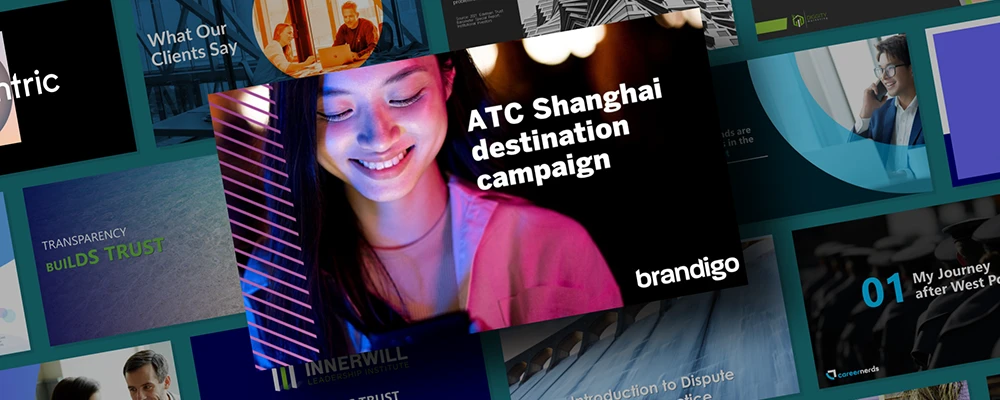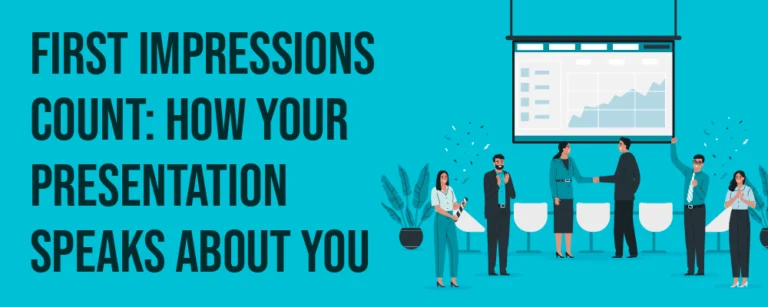
Table of Contents
In a world filled with information overload, capturing an audience’s attention has become an art. Gone are the days when a mere slideshow with bullet points could captivate an audience. Today, presentations need to be engaging, captivating, and memorable. Presentation design is no longer just about pretty pictures; it’s a secret weapon that can transform an ordinary presentation into an extraordinary experience.
The Essence of an Effective Presentation
What separates a mediocre presentation from a remarkable one? The answer lies in its essence. An effective presentation goes beyond the superficial. It tells a compelling story, engages the audience on an emotional level, and leaves a lasting impression. It leaves the audience wanting more, hungry for knowledge, and eager to take action.
But how do you achieve such impact? It starts with understanding your audience. What are their needs, desires, and pain points? Tailor your presentation accordingly, addressing their concerns and providing valuable insights that resonate with them.
Imagine you are standing in front of a room full of people, all eager to hear what you have to say. The lights dim, and the projector screen illuminates with your first slide. As you begin to speak, you notice the attentive faces in the crowd. You can feel the energy in the room, the anticipation of what you are about to share.
Your presentation is not just a collection of slides and bullet points. It is a carefully crafted narrative, designed to captivate and inspire. You have taken the time to research your audience, to understand their needs and desires. You know that they are seeking solutions to their problems, and you are here to provide them.
You start by sharing a personal story, something that resonates with the audience. You want them to connect with you on a deeper level, to see that you understand their struggles and challenges. As you speak, you can see the nods of recognition, the smiles of empathy.
But it’s not just about the story. It’s about the way you deliver it. Your voice is confident and clear, your body language open and inviting. You make eye contact with different individuals in the audience, making them feel seen and heard. You use gestures and facial expressions to emphasize key points, to add depth and meaning to your words.
As you move through your presentation, you provide valuable insights and practical tips. You share case studies and success stories, illustrating how others have overcome similar challenges. You offer actionable steps that the audience can take to achieve their goals.
But it’s not just about the information. It’s about the emotions you evoke. You use powerful visuals and evocative language to create an emotional connection with the audience. You make them feel inspired, motivated, and ready to take action.

Throughout your presentation, you engage the audience through interactive activities and thought-provoking questions. You encourage them to participate, to share their own experiences and insights. You create a sense of community, a space where everyone feels valued and included.
As you reach the end of your presentation, you leave the audience with a sense of empowerment. You remind them of the potential within themselves, of the possibilities that lie ahead. You encourage them to continue their journey, to take the knowledge and insights they have gained and apply them in their own lives.
An effective presentation is not just about delivering information. It is about creating an experience, a transformative moment that stays with the audience long after the presentation is over. It is about inspiring and empowering others to reach their full potential.
Why Presentations Fail
It’s no secret that presentations fail more often than they succeed. But why is that the case? The answer lies in the lack of attention to detail. Many presenters focus solely on the content, neglecting the design aspect altogether. Others rely too heavily on text-heavy slides, overwhelming the audience with information, and losing their attention along the way.
Poorly designed presentations suffer from information overload, lack of clarity, and a failure to engage the audience. Bullet points and lengthy paragraphs bore the audience and make it difficult for them to retain information. To avoid these pitfalls, it’s crucial to prioritize visual design and storytelling.
When it comes to presentations, the devil is in the details. The smallest oversight can have a significant impact on the overall effectiveness of your message. From the choice of font to the color scheme, every element should be carefully considered to create a visually appealing and cohesive presentation.
Additionally, the structure and organization of your content play a vital role in capturing and maintaining the audience’s attention. A well-crafted presentation should have a clear and logical flow, guiding the audience through the information in a way that is easy to follow and understand.
Visual aids, such as images, charts, and graphs, can greatly enhance the impact of your presentation. They provide visual representations of data and concepts, making them easier to grasp and remember. However, it’s important to strike a balance between using visuals and overwhelming the audience with too much information. Each visual should serve a purpose and support your key points.
Another common pitfall in presentations is the excessive use of jargon and technical terms. While it’s important to demonstrate expertise in your field, it’s equally important to communicate your ideas in a way that is accessible to a diverse audience. Using plain language and avoiding unnecessary jargon will help ensure that your message resonates with everyone in the room.
Storytelling is a powerful tool in presentations. It helps create an emotional connection with the audience and makes your message more memorable. By incorporating personal anecdotes, case studies, or real-life examples, you can bring your content to life and engage the audience on a deeper level.
Lastly, practice and preparation are key to delivering a successful presentation. Rehearsing your delivery, timing, and transitions will help you feel more confident and comfortable on stage. It will also allow you to anticipate potential challenges and make necessary adjustments to ensure a smooth and impactful presentation.

Key Elements for Successful Presentations
What are the key elements that separate successful presentations from the rest? It starts with a compelling narrative. Every great presentation tells a story that captures the audience’s imagination, taking them on a journey from problem to solution.
In addition to storytelling, successful presentations are concise and focused. They communicate key messages clearly, using visual aids to reinforce important points. Images, graphs, and charts are powerful tools that can convey complex information in a digestible and memorable way. A well-designed slide deck can turn a mundane presentation into an extraordinary experience.
When crafting a compelling narrative, it is important to consider the audience’s needs and interests. Understanding their perspective allows presenters to tailor their story to resonate with the listeners. By incorporating relatable examples and anecdotes, presenters can create an emotional connection that captivates the audience.
Furthermore, successful presentations utilize effective communication techniques to engage the audience. This includes maintaining eye contact, using appropriate body language, and speaking with clarity and confidence. By establishing a strong presence, presenters can establish credibility and build trust with their audience.
Visual aids play a crucial role in enhancing the overall impact of a presentation. When used strategically, they can help clarify complex concepts, highlight key data points, and reinforce the main messages. However, it is important to strike a balance and avoid overwhelming the audience with too many visuals. Selecting high-quality images, creating visually appealing graphs, and designing clear and concise charts are essential for creating a visually compelling presentation.
Moreover, successful presenters understand the importance of rehearsal and preparation. By practicing their delivery and familiarizing themselves with the content, presenters can ensure a smooth and confident performance. Rehearsing also allows presenters to identify areas that may need improvement, such as timing, transitions, or the flow of the narrative.
Lastly, successful presentations leave a lasting impression by incorporating interactive elements. This can include engaging the audience through questions, encouraging participation, or incorporating hands-on activities. By involving the audience in the presentation, presenters create a sense of involvement and make the experience more memorable.
Successful presentations are a combination of compelling storytelling, concise communication, effective use of visual aids, preparation, and audience engagement. By incorporating these key elements, presenters can deliver impactful presentations that captivate and inspire their audience.
Presentation Design: More Than Just Pretty Pictures
Presentation design is often mistaken for simply creating visually appealing slides. While aesthetics are important, design goes beyond pretty pictures. It encompasses the entire user experience, from the moment the presentation begins to the final applause.
Effective presentation design involves careful consideration of fonts, colors, and visual hierarchy. It ensures that the content is easily readable and visually pleasing. It takes into account the use of white space to reduce clutter and create a sense of balance. Design-led presentations create a harmonious flow that guides the audience’s attention, keeping them engaged throughout.
When it comes to fonts, presentation designers understand the importance of choosing the right typeface. They consider factors such as legibility, readability, and appropriateness for the content and audience. A well-chosen font can convey the tone and message of the presentation, enhancing the overall impact.
Colors play a crucial role in presentation design as well. Designers carefully select color palettes that complement the content and evoke the desired emotions. They understand the psychology of colors and how different hues can influence the audience’s perception and engagement. By using colors strategically, designers can create a visually cohesive and impactful presentation.
Visual hierarchy is another key aspect of effective presentation design. Designers utilize various techniques such as size, contrast, and placement to guide the audience’s attention and emphasize important information. By establishing a clear visual hierarchy, designers ensure that the audience can easily navigate the presentation and grasp the main points.
White space, also known as negative space, is an essential element in presentation design. It refers to the empty areas between elements on a slide. Designers use white space to create breathing room and prevent overcrowding. By strategically incorporating white space, designers enhance the overall clarity and readability of the presentation, allowing the audience to focus on the key content without distractions.
Furthermore, effective presentation design goes beyond aesthetics and considers the overall structure and flow of the content. Designers carefully organize the information, ensuring a logical progression and a seamless narrative. They break down complex concepts into digestible chunks, using headings, subheadings, and bullet points to facilitate understanding. By structuring the content effectively, designers enable the audience to follow along easily and retain the information presented.
Presentation design is more than just creating visually appealing slides. It involves a thoughtful and strategic approach to fonts, colors, visual hierarchy, white space, and overall content structure. Design-led presentations captivate the audience, enhance comprehension, and leave a lasting impression. So, the next time you prepare a presentation, remember that design is not just about pretty pictures, but about creating an immersive and impactful experience for your audience.

Storytelling in Presentations: A Must
Storytelling has always been a powerful tool for human connection. It evokes emotions, engages the imagination, and leaves a lasting impact. Incorporating storytelling into presentations is essential to create a memorable experience for the audience.
Imagine yourself sitting in a conference room, surrounded by a sea of faces. The presenter steps up to the podium, armed with a slide deck and a monotone voice. As they begin to speak, you feel your attention waning. The information being presented is important, but it’s difficult to stay engaged.
Now, let’s rewind and imagine a different scenario. The presenter starts their presentation with a captivating story. They paint a vivid picture of a relatable situation, drawing you in with their words. Suddenly, you’re hooked. You want to know what happens next. The information being presented is seamlessly woven into the narrative, making it easier to understand and remember.
By weaving a narrative into your presentation, you can turn a dry topic into a captivating journey. Start with a relatable anecdote, introduce a protagonist facing a challenge, and offer a resolution that leaves the audience inspired. Storytelling not only grabs attention but also helps the audience relate to the content on a deeper level.
Think about the last time you watched a movie or read a book that deeply resonated with you. Chances are, it wasn’t just the plot or the characters that made it memorable. It was the emotions it evoked, the way it made you feel. The same principle applies to presentations. By incorporating storytelling techniques, you can create an emotional connection with your audience.
Furthermore, storytelling helps to make complex information more accessible. When presented with a list of facts and figures, our brains often struggle to process and retain the information. However, when that information is presented within the context of a story, it becomes easier to understand and remember. Stories have a way of simplifying complex concepts, making them more relatable and digestible.
Additionally, storytelling has the power to inspire and motivate. When you share a personal story or an anecdote about someone who overcame great odds, you tap into the audience’s emotions. You ignite a spark within them, encouraging them to believe in their own potential. By sharing stories of triumph and resilience, you can leave a lasting impact on your audience, motivating them to take action and make a difference.
Storytelling is not just a nice addition to a presentation; it is a must. By incorporating storytelling techniques, you can create a memorable experience for your audience, make complex information more accessible, and inspire them to take action. So, the next time you prepare a presentation, remember the power of storytelling and harness it to captivate your audience.
Making the Most of Your Presentations: How Design Can Help
Now that we’ve established the importance of design in presentations, let’s explore how it can help you make the most of your efforts. Design allows you to convey complex ideas in a visually appealing and comprehensible manner, helping your audience understand and retain information more effectively.
With effective design, you can create visual cues that guide your audience’s attention. Use images strategically to evoke emotions and create a connection with your message. Utilize color to highlight key points and create a visual hierarchy that directs the audience’s focus.
By leveraging design techniques, you can turn your presentation into an immersive experience that leaves a lasting impact.
Design-Led Presentations: How to Make Your Audience Listen
Design-led presentations have the power to captivate an audience’s attention and make them truly listen. But how do you create a design-led presentation that resonates with your audience?
First and foremost, it’s essential to understand your audience’s needs and tailor your presentation accordingly. Identify their pain points and address them directly. Utilize visuals, storytelling, and compelling design to deliver your message in a way that sparks curiosity and engages their emotions.
Remember, design is not just about aesthetics; it’s about enhancing the user experience. Utilize fonts, colors, and layouts that are visually pleasing and support your content. Use visuals to reinforce your message and create an emotional connection with your audience.
Design is no longer an afterthought in presentations; it’s a secret weapon that can transform a lackluster presentation into a standing ovation. By understanding the elements of an effective presentation, prioritizing visual design, and incorporating storytelling, you can create presentations that leave a lasting impression and inspire action. Embrace design as your secret weapon, and watch as your presentations captivate, engage, and inspire your audience like never before.




